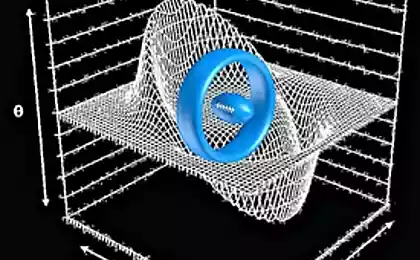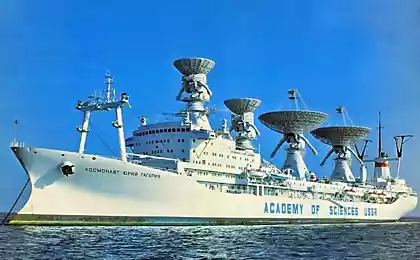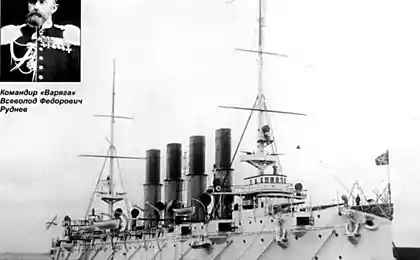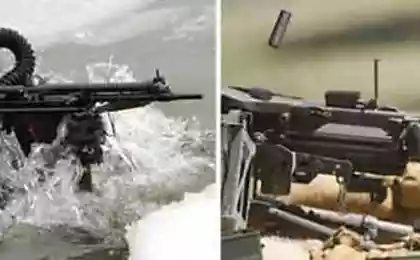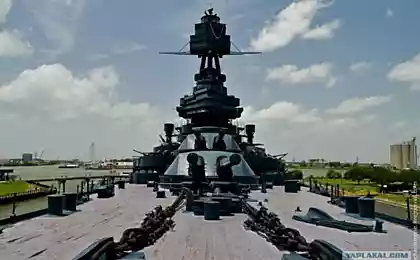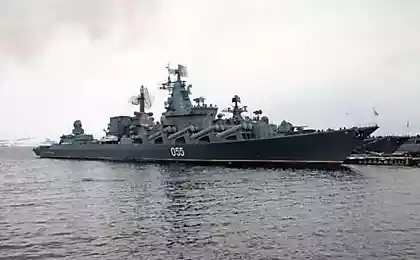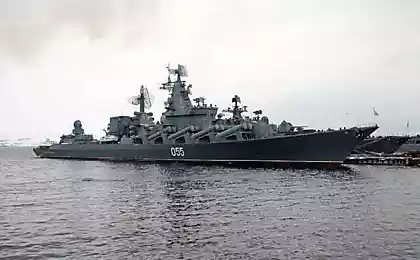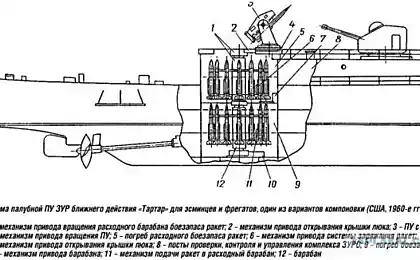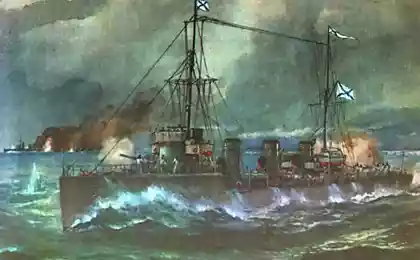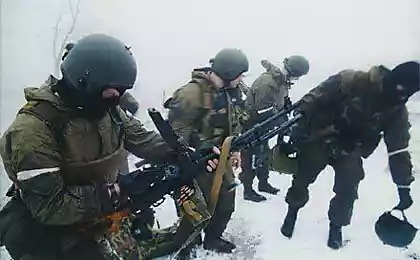1023
Special Purpose Ships
That's decided to tell you about the most interesting (in my opinion) of special purpose vehicles.
X-Band Radar
This amazing floating structure, which is crowned with something that looked like a huge egg, in fact, is the first of its kind floating radar that was created by the Americans in the 2006 year.
Radar is called the Sea-Based X-Band Radar (SBX) and is designed to detect launches of intercontinental ballistic missiles.
But interestingly, the platform for this important element of the US missile defense system was built Russian.
The whole structure weighing 50 000 tonnes (for a moment) and a height of 86 meters (about as a 20-storey building!) Can move at a speed not exceeding 13 km / h.
At the moment, this edifice can be seen near the Hawaiian Islands.
23 photos + video
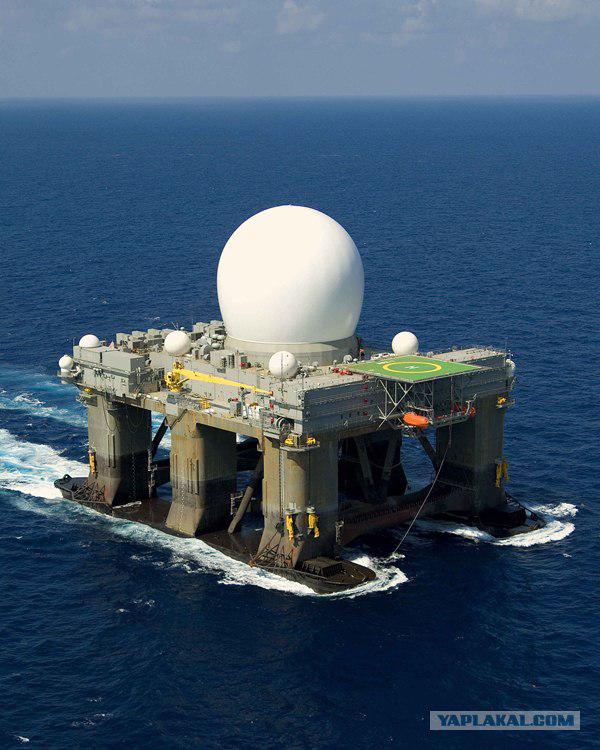
In 2006, the Americans created a first of its kind floating marine radar, the value of which exceeded 815 million dollars. Novelty called Sea-Based X-Band Radar (SBX). According to the military, the main task of SBX - detecting launches of intercontinental ballistic missiles.
"Marine Radar" is one of the key elements of the US missile defense system - Ground-based Midcourse Defense system (GMD).
As the name implies, this system will focus its attention on the middle portion of the flight warheads. It is in this area (outside the atmosphere) interceptor missiles and will have to shoot down enemy "missiles».
SBX is designed to detect and track space objects, including high-speed and small, as well as the development of targeting data. According to the developers, the radar has a highly selective and noise immunity, it can effectively "weed out" numerous decoys, exhibited from warheads and ballistic missiles designed to hide the real warhead. The station also has the ability to evaluate the results of the use of interceptor missiles warhead ballistic missiles and, in the case of failure to issue a command to re-use missile defense. The mobile station is in addition SBX station prototype XBR stationary land-based.
SBX radar itself weighs 2000 tons. Structurally, it is designed as a so-called phased array antenna array and has 69 thousand 632 multifrequency receiving-emitting modules. The Pentagon hopes that the radar, which will work in the centimeter range, can very accurately distinguish real warheads from decoys in the intermediate portion of their flight trajectory.
The total weight of the self-propelled radar installation is 50 thousand tons. The height of the buildings, from the keel to the top of the radar dome - 86 meters. The main deck has a size of 70 x 119 metrov.Ogromnaya design with a height of 20-storey house is able to move independently in the ocean waters at speeds up to 7 knots (13 km) and can be relocated to any point of the ocean surface to detect missiles.
Information from it will flow into the command center in Colorado Springs (Colorado), and then - to the army base in Fort Greely in Alaska and Vandenberg Air Force Base in California, where there are the first interceptor missiles. A similar radar, dubbed "Cobra Dane", is planned to create on the island of Shemya, also a part of the Aleutian chain.
On how he will be protected from attack by enemy radar - have not been announced yet, it is possible to place it on the short-range systems such as Sea Sparrow or Volcano MK.15.
Structurally, the SBX radar is installed with providing a self-propelled semi-submersible equipment on the oil platform CS-50, built in 2001 on the Russian Vyborg shipyard and was originally designed for oil production in the North Sea (originally called platform «Moss Sirius»). The contract worth $ 45 million. Was issued by the Norwegian company Moss Maritime (now part of an offshore company Saipem). After the transfer of the customer platform was acquired by Boeing Corporation for the project Sea-based X-band Radar, implemented through the US Department of Defense.
Conversion platform «Moss Sirius» was produced at the company's shipyard AmFELS in Brownsville (Brownsville, USA), on the border with Mexico. Module with radar station was assembled and installed on the platform specialists shipyard companies Kiewit Offshore Services in the city of Ingleside (Ingleside), near the city of Corpus Christi (Corpus Christi, TX) - on the northern coast of the Gulf of the same name. As for the radar station, its development and production contract with the Boeing Corporation is engaged in Unit Integrated Defense Systems company Raytheon. Delivery of the equipment of the satellite guidance and integration of the various systems on the platform of the company does Harris Corporation - is also under contract with the corporation Boeing. It also supplies equipment for satellite communications with ground control points. The contract worth $ 7, 7 million. Was issued September 17, 2003
However, among the military itself is not unique point of view on the new marine radar. Active US military evade comment, but Philip Coyle, the secretary of the Minister of Defense during prezidentstvovaniya Bill Clinton (1994-2001), expects that this development - a waste of money, since the development SBX spent nearly a billion dollars, but ocean storms , salt water and constant winds in the ocean will be very adversely affect sverhchustvitelnye instruments news. Moreover, Coyle said that such development would be better to place somewhere in a quiet mountain area, not in the ocean.
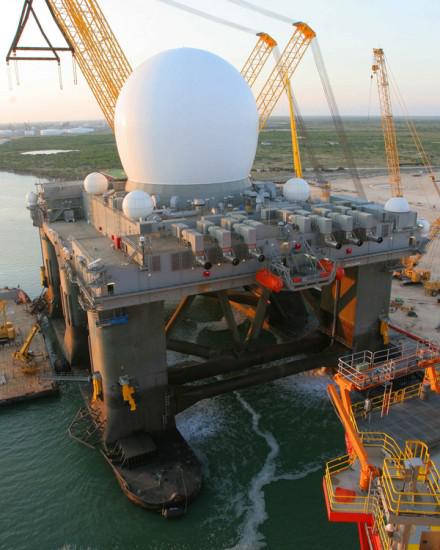
Three

Four
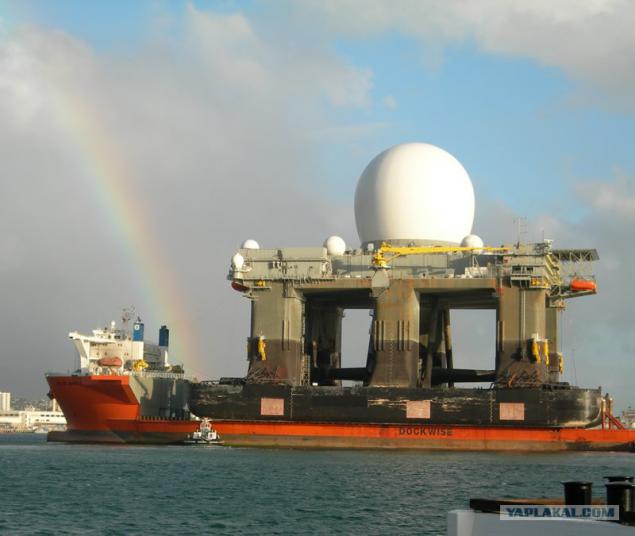
Five
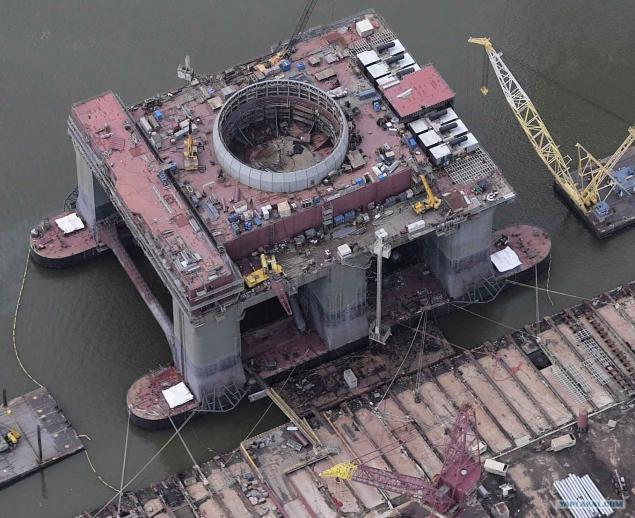
Six
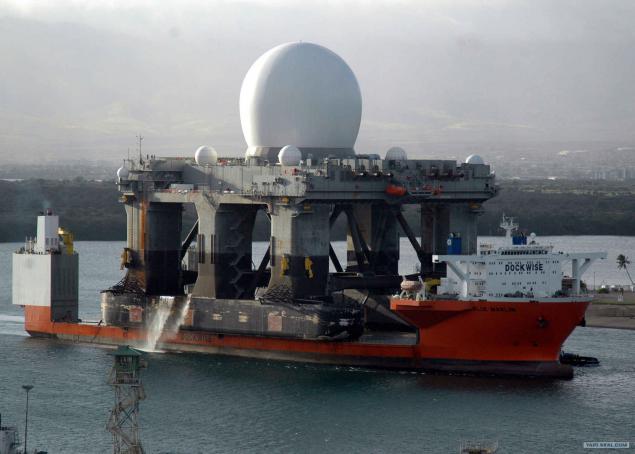
Seven
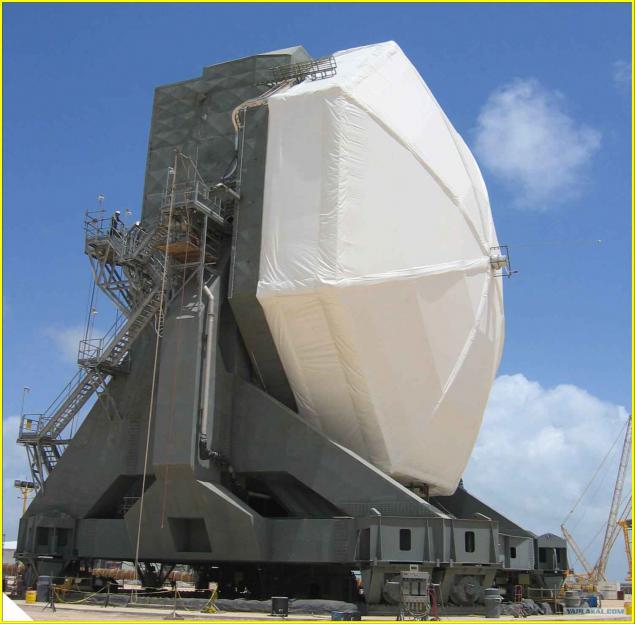
eight
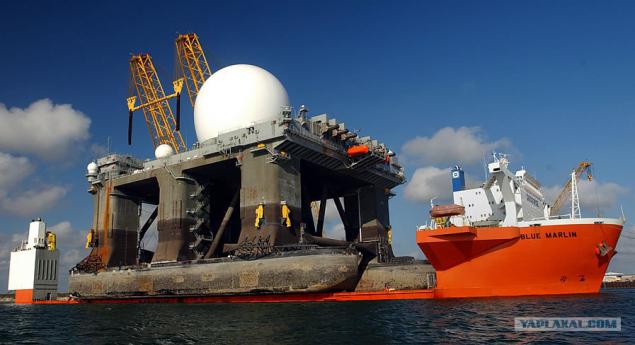
Sea Shadow
Built / launched in 1993.
Length: 49, 9 m
Width: 20, 7 m
Displacement: 560 tons
Cruising 2250 miles
Draft: 4, 3 m
Crew: 12
Speed: 13 knots
Specialists of the American corporation "Lockheed Martin" designed and built an experimental stealth ship "Sea Shadow" in 1993. Above-water part of this very unusual ship rests on two narrow underwater housing, which reduces the resistance of the waves, and hence to minimize unmasking a wake. Supporting structures that connect at an angle of 45 degrees to the body surface and underwater, not only increase the lateral stability of the vessel, but also reduce its effective area of dispersion (EPR) - characteristic radar signature. The special structure of the metal body makes the beam of ship and aircraft radars (radar) does not come back, as it were, bouncing to the side. Fore and aft ends, too, are made in such a way that "otpasovyvat" radar rays. Plus a special radar-absorbing composition, covering places pairing of hull structures (those bumps - major sources of radar visibility).
Sailors brought to its technology, the original elements are missing from the basic set of software invisibility. In particular, include the establishment of the hangings around the ship sets the smallest spray, which significantly reduces its own radiation in the infrared (thermal) wavelength range and reduces the efficiency of high-frequency radar.
Experts "Lockheed" no accident took for the creation of "Sea Shadow". It is the corporation was constructed the world's first serial fighter technology "stealth» - F-117A «Night Hawk" ("Night Hawk").
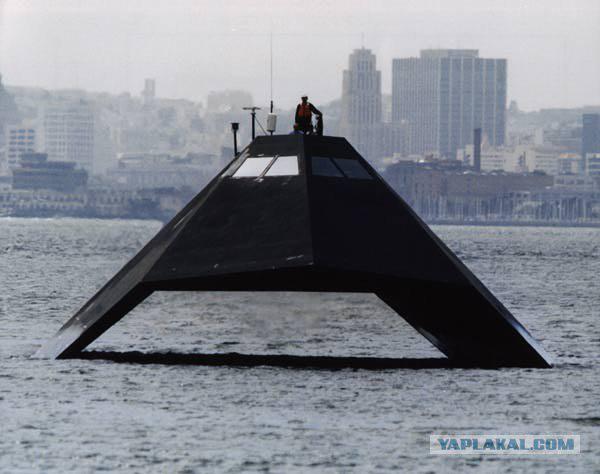
Ten
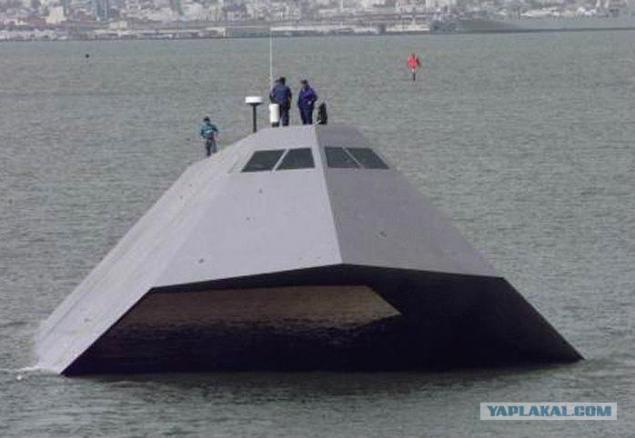
Eleven
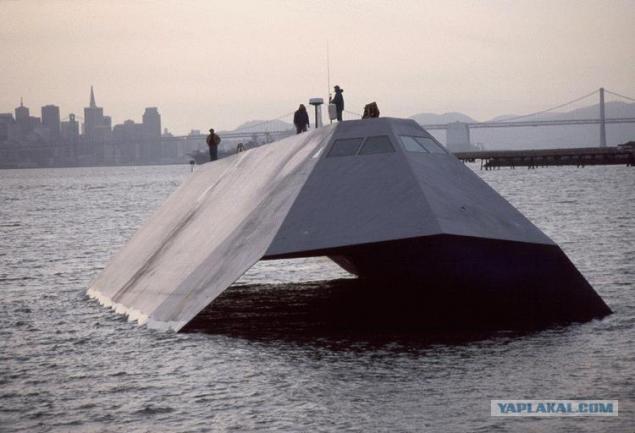
twelve
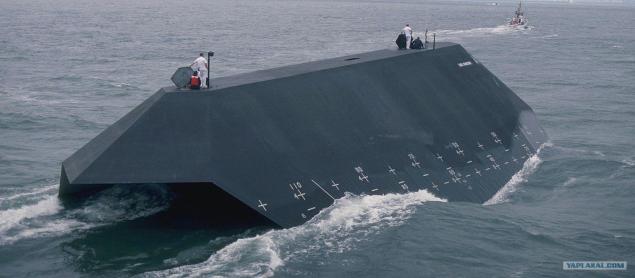
Thirteen
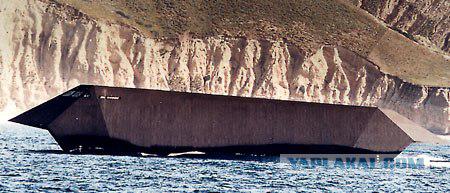
SSP-1 Kaimalino
Built / launched in 1973.
Length: 30 m
Width: 15 m
Displacement: 190 tons
Draught: 5 m
Crew: 8
Speed: 25 knots
Armament
Helicopters 1
Finding the most effective naval Form Creation led to a catamaran, or rather, "Katta Marani", which translated from the language Tomilov inhabiting the coast of southern India and o.Tseylon means "Twin Trees". These vessels have been known to man since ancient times. They consisted of a boat, connected to a log-counterweight or structure of two or more connected to each other boats. Catamarans have always been known as good walkers.
Nowadays catamaran is usually called the court consisting of two buildings connected by a rigid structure - a "bridge", or those who have made the nose of the monohull and aft body splits.
The stability of the catamaran is provided by a large distance between the hulls, which can dramatically reduce the width of the hull to a minimum, limited type buoyancy. However, each striving to narrow the body leads to a sharp increase in rainfall, and the rainfall increases with increasing wetted surface and the frictional resistance, but significantly reduced impedance. These are precisely the conditions that are preferred for high-speed ships.
But here, not without a "but". By increasing the ratio of the length to the width of the body mass of the body increases. In addition, when an excessively large wave formation sediment catamaran becomes comparable to the same displacement of single-hull ship, and sometimes exceeds it.
In an attempt to remedy this lack of specific shipbuilders have turned to semi-submersible scheme, sometimes referred to as the float. The design consists of two bearing shell cigar-shaped submarine, joined by longitudinal struts to the platform above the water - bridge. In this embodiment, the area of the existing water line is sharply reduced. Reduced water resistance movement of the ship due to the almost complete exclusion of the wave resistance.
In addition, improving the seaworthiness of the ship in stormy weather. Characteristics of Conduct ship in rough seas (pitching wave sweeping, speed reduction) determined perturbing forces, the size of which depends on the sea state and the form of lines of the hull. Contours of the body, in turn, are characterized by size, shape and size of the existing water line. In view of these considerations, the US Navy experts are paying serious attention to the development of semi-submersible catamaran type of SWATH (Small Waterplane Area Twin Hull).
Also good ride and seaworthiness of ships SWATH type are characterized by above-water hull, the shape of which is not limited by the requirements of hydrodynamics.
In 1969, commissioned by the US Navy developed the experimental semi-submersible catamaran "Kaimalino" gas turbine power plant with a capacity of 4000 liters. from. and full speed of 25 knots. In 1973. the ship was built, and ever since it practiced concerns and constructive solutions. In 1993, this principle is built ship Invisible Sea Shadow.
In the United States carried out design studies such as SWATH ships in versions of aircraft carriers, destroyers and patrol ships. Model tests showed that the gain in power plant capacity compared to similar ships could reach about 50 percent.
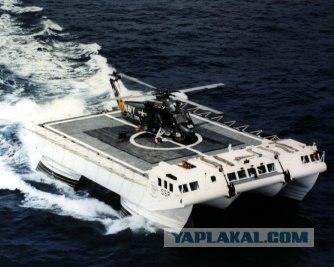
Fifteen
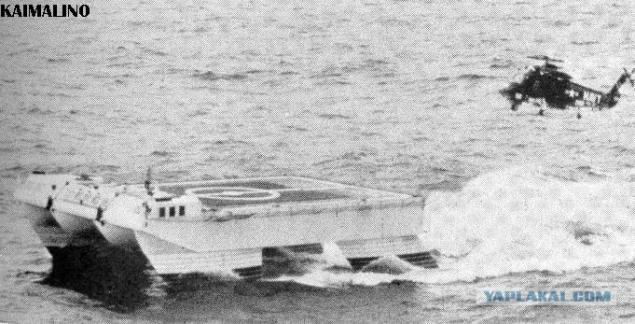
SSX-1
Built / lowered 1955/1985
Length: 15 m 2
Displacement: 36 tons
Immersion depth: 15 m
Crew: 2
Submarine «SSX-1" (second designation X-1) is designed to deliver a secretive reconnaissance and sabotage groups laying mines in ports and bases, as well as for destruction by a legkovodolazov underwater obstacles during amphibious operations.
Housing «SSX-1" has faired well with virtually no protruding parts. The robust housing is divided into two sections: habitable, which houses the crew and control devices, and a desert, where the engine is installed with the servo-mechanism.
The bow of the manned compartment height divided into two tiers solid platform. At the bottom is airlock to exit legkovodolazov, and in the upper part there are two beds, battery, high pressure air cylinders and oxygen. On «SSX-1" is set hatch lid is closed by folding a sheet of the superstructure. In the same compartment installed hydroacoustic instruments, apparatus for air conditioning, remote control submarine and motor control panel of the same plane.
Diesel set in a deserted bay, running on a single cycle of hydrogen peroxide, the stock of which is stored in the bow hull in the tank volume of 1680 liters.
Because of the increased explosion - and fire power plant in the «SSX-1" in February 1958, an explosion occurred. Renovated in December 1960 it mounted a conventional diesel-electric installation.
Since «SSX-1" is designed for sabotage and intelligence operations, the possibility of transporting it on airplanes and helicopters. To facilitate such transport body it is made of three blocks bolted, wherein the assembly can be carried by the crew of the boat.
Permanent crew of the boat consists of two officers, drivers, radio operators, sonar and mechanics. In addition, the submarine can accommodate four more legkovodolazov saboteurs.
To create normal working conditions of staff, located in the very cramped conditions in a submarine capacity for air conditioning cooling capacity of about 40,000 kcal / h.
Midget submarine «SSX-1" is used in exercises and maneuvers to infiltrate subversive means in these protected ports and bases, as well as to develop combat tactics midget submarines of the enemy.
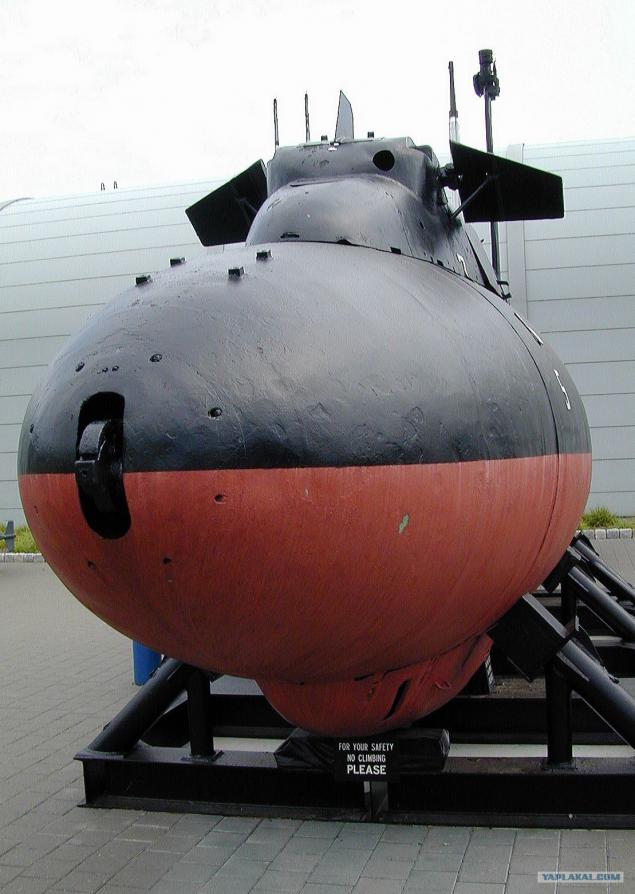
Seventeen
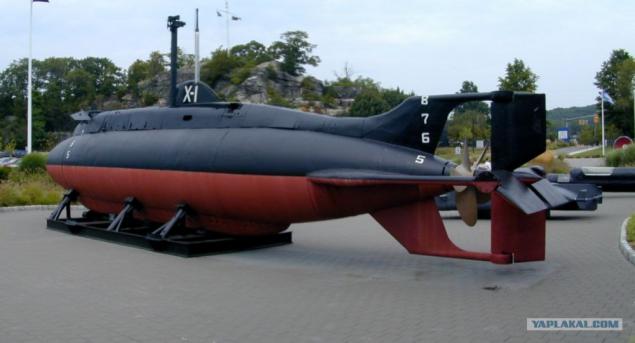
Eighteen
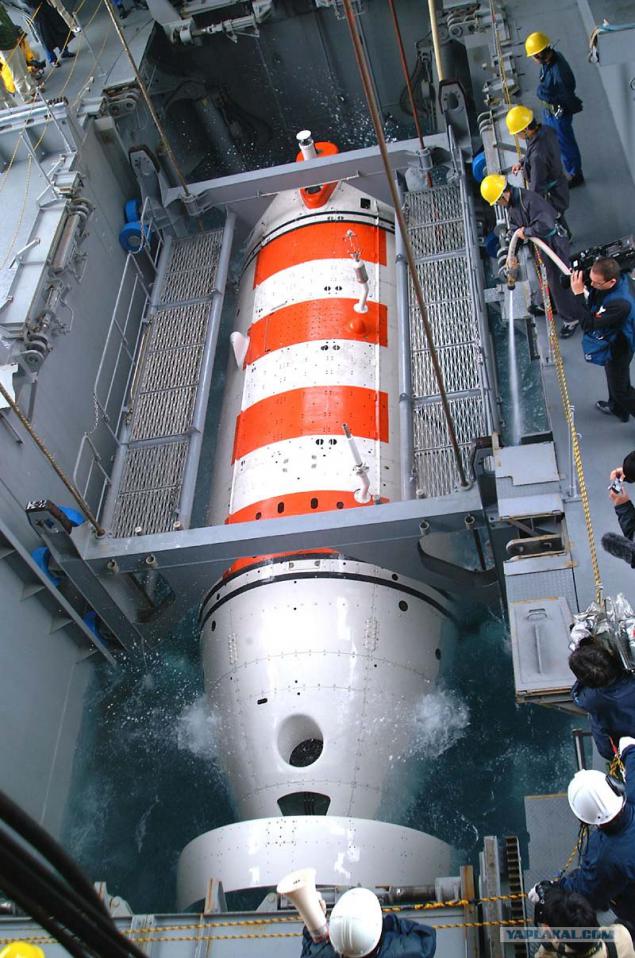
AS-33 Simon Lake
Built / lowered 1964/1999
Length: 193 m
Width: 22, 5 m
Displacement: 22,250 tons
Draught: 9, 1 m
Crew: 1500
Speed: 18 knots
Armament
Anti-aircraft installation 4 20 mm
In 1963 - 64 years. for naval forces of the USA has built two mother ships of the same type such as "Simon Lake." Each of them can provide the basing of 9 - 12, and at the same time serve 3 - 4 nuclear missile submarines.
The main purpose of these mother ships - to restore the fighting efficiency of nuclear submarines in mezhpohodovy period (supply them with all kinds of material and technical means, including missiles and torpedoes, producing mezhpohodovy repair and accommodation aboard mother ships personnel submarines to send him to rest in the rear bases ).
Floating base type "Simon Lake" from mother ships such as the Hunley are large production capacity and a wider range of subjects dosnabzheniya submarines. In addition, the new mother ships cargo unit allows simultaneous unloading of two missiles from submarines.
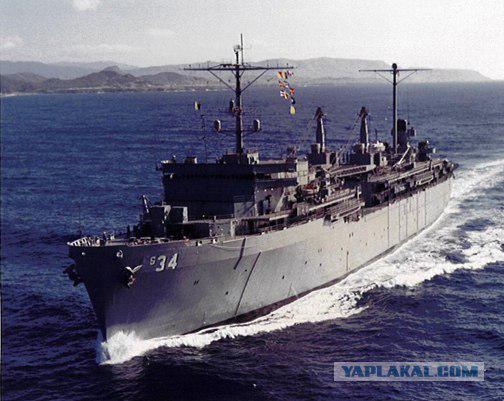
Twenty
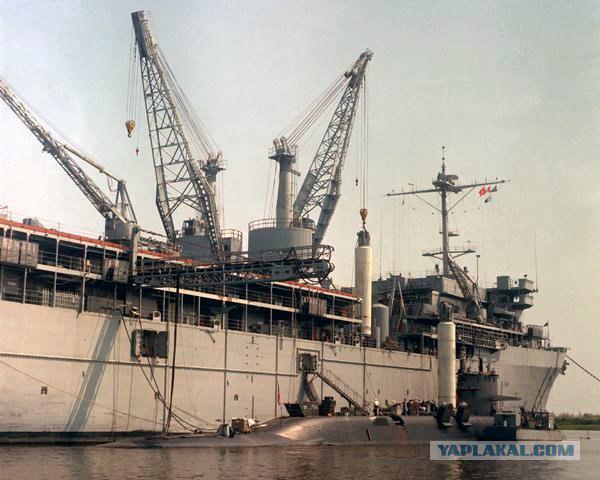
DSRV
Length: 15 m
Width: 2 to 4 m
Displacement: 38 tons
Depth: 1,524 meters
Crew: 4
Speed: 4 knots
US Navy set out to build deep-water rescue vehicles (GSA) in the late sixties, after the death of the nuclear submarine Thresher.
In the early 1970s in the US Navy included two types GSA «DSRV». These GSA designed to quickly assist the sunken submarine in any part of the world's oceans, and they can be transported by a special trailer, transport aircraft C-5A and C-141, as well as surface ships and specially designed multi-purpose submarines (currently eight US, four British and a French nuclear submarine can carry American GAW under water). If necessary, the GSA can help emergency submarines under the ice.
Light body type GSA «DSRV» is made of fiberglass. Rugged consists of three compartments spherical diameter of 2, 286 m, interconnected transition hatches, and is made of high strength steel. In the forward compartment located control system and the crew commander and his assistant, two operators. In the middle and aft compartments can accommodate up to 24 saves. In the middle section there are two hatches: the bottom is connected to a docking device shaft transition, the top is to exit the GSA.
To search for the sunken submarine GSA is equipped with a variety of electronic equipment, including sonar station equipment sonar communication and TV cameras. In addition, the GSA is equipped with a manipulator to clear rescue the submarine hatch, if it littered with debris. Joining GSA with submarines available in roll and pitch to 450.
Currently, the service life of the GAW ends. They must replace a new deep-water rescue complexes consisting of the UK and the decompression chamber. The complex will also be able to be transported by air.
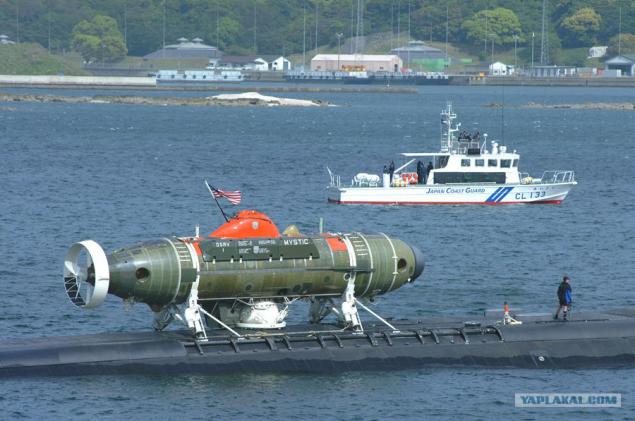
Twenty-two
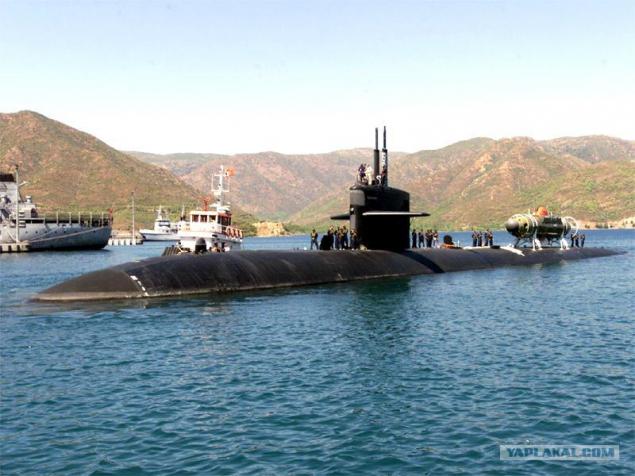
And as a bonus HSV
Cruising: 1200 miles
Draught: 4 m 2
Gruzopodёmnost 815 tonnes
Length: 101 m
Width: 26, 6 m
Crew: 45
Speed: 48 knots
Armament
Helicopters 1
Source:
X-Band Radar
This amazing floating structure, which is crowned with something that looked like a huge egg, in fact, is the first of its kind floating radar that was created by the Americans in the 2006 year.
Radar is called the Sea-Based X-Band Radar (SBX) and is designed to detect launches of intercontinental ballistic missiles.
But interestingly, the platform for this important element of the US missile defense system was built Russian.
The whole structure weighing 50 000 tonnes (for a moment) and a height of 86 meters (about as a 20-storey building!) Can move at a speed not exceeding 13 km / h.
At the moment, this edifice can be seen near the Hawaiian Islands.
23 photos + video

In 2006, the Americans created a first of its kind floating marine radar, the value of which exceeded 815 million dollars. Novelty called Sea-Based X-Band Radar (SBX). According to the military, the main task of SBX - detecting launches of intercontinental ballistic missiles.
"Marine Radar" is one of the key elements of the US missile defense system - Ground-based Midcourse Defense system (GMD).
As the name implies, this system will focus its attention on the middle portion of the flight warheads. It is in this area (outside the atmosphere) interceptor missiles and will have to shoot down enemy "missiles».
SBX is designed to detect and track space objects, including high-speed and small, as well as the development of targeting data. According to the developers, the radar has a highly selective and noise immunity, it can effectively "weed out" numerous decoys, exhibited from warheads and ballistic missiles designed to hide the real warhead. The station also has the ability to evaluate the results of the use of interceptor missiles warhead ballistic missiles and, in the case of failure to issue a command to re-use missile defense. The mobile station is in addition SBX station prototype XBR stationary land-based.
SBX radar itself weighs 2000 tons. Structurally, it is designed as a so-called phased array antenna array and has 69 thousand 632 multifrequency receiving-emitting modules. The Pentagon hopes that the radar, which will work in the centimeter range, can very accurately distinguish real warheads from decoys in the intermediate portion of their flight trajectory.
The total weight of the self-propelled radar installation is 50 thousand tons. The height of the buildings, from the keel to the top of the radar dome - 86 meters. The main deck has a size of 70 x 119 metrov.Ogromnaya design with a height of 20-storey house is able to move independently in the ocean waters at speeds up to 7 knots (13 km) and can be relocated to any point of the ocean surface to detect missiles.
Information from it will flow into the command center in Colorado Springs (Colorado), and then - to the army base in Fort Greely in Alaska and Vandenberg Air Force Base in California, where there are the first interceptor missiles. A similar radar, dubbed "Cobra Dane", is planned to create on the island of Shemya, also a part of the Aleutian chain.
On how he will be protected from attack by enemy radar - have not been announced yet, it is possible to place it on the short-range systems such as Sea Sparrow or Volcano MK.15.
Structurally, the SBX radar is installed with providing a self-propelled semi-submersible equipment on the oil platform CS-50, built in 2001 on the Russian Vyborg shipyard and was originally designed for oil production in the North Sea (originally called platform «Moss Sirius»). The contract worth $ 45 million. Was issued by the Norwegian company Moss Maritime (now part of an offshore company Saipem). After the transfer of the customer platform was acquired by Boeing Corporation for the project Sea-based X-band Radar, implemented through the US Department of Defense.
Conversion platform «Moss Sirius» was produced at the company's shipyard AmFELS in Brownsville (Brownsville, USA), on the border with Mexico. Module with radar station was assembled and installed on the platform specialists shipyard companies Kiewit Offshore Services in the city of Ingleside (Ingleside), near the city of Corpus Christi (Corpus Christi, TX) - on the northern coast of the Gulf of the same name. As for the radar station, its development and production contract with the Boeing Corporation is engaged in Unit Integrated Defense Systems company Raytheon. Delivery of the equipment of the satellite guidance and integration of the various systems on the platform of the company does Harris Corporation - is also under contract with the corporation Boeing. It also supplies equipment for satellite communications with ground control points. The contract worth $ 7, 7 million. Was issued September 17, 2003
However, among the military itself is not unique point of view on the new marine radar. Active US military evade comment, but Philip Coyle, the secretary of the Minister of Defense during prezidentstvovaniya Bill Clinton (1994-2001), expects that this development - a waste of money, since the development SBX spent nearly a billion dollars, but ocean storms , salt water and constant winds in the ocean will be very adversely affect sverhchustvitelnye instruments news. Moreover, Coyle said that such development would be better to place somewhere in a quiet mountain area, not in the ocean.

Three

Four

Five

Six

Seven

eight

Sea Shadow
Built / launched in 1993.
Length: 49, 9 m
Width: 20, 7 m
Displacement: 560 tons
Cruising 2250 miles
Draft: 4, 3 m
Crew: 12
Speed: 13 knots
Specialists of the American corporation "Lockheed Martin" designed and built an experimental stealth ship "Sea Shadow" in 1993. Above-water part of this very unusual ship rests on two narrow underwater housing, which reduces the resistance of the waves, and hence to minimize unmasking a wake. Supporting structures that connect at an angle of 45 degrees to the body surface and underwater, not only increase the lateral stability of the vessel, but also reduce its effective area of dispersion (EPR) - characteristic radar signature. The special structure of the metal body makes the beam of ship and aircraft radars (radar) does not come back, as it were, bouncing to the side. Fore and aft ends, too, are made in such a way that "otpasovyvat" radar rays. Plus a special radar-absorbing composition, covering places pairing of hull structures (those bumps - major sources of radar visibility).
Sailors brought to its technology, the original elements are missing from the basic set of software invisibility. In particular, include the establishment of the hangings around the ship sets the smallest spray, which significantly reduces its own radiation in the infrared (thermal) wavelength range and reduces the efficiency of high-frequency radar.
Experts "Lockheed" no accident took for the creation of "Sea Shadow". It is the corporation was constructed the world's first serial fighter technology "stealth» - F-117A «Night Hawk" ("Night Hawk").

Ten

Eleven

twelve

Thirteen

SSP-1 Kaimalino
Built / launched in 1973.
Length: 30 m
Width: 15 m
Displacement: 190 tons
Draught: 5 m
Crew: 8
Speed: 25 knots
Armament
Helicopters 1
Finding the most effective naval Form Creation led to a catamaran, or rather, "Katta Marani", which translated from the language Tomilov inhabiting the coast of southern India and o.Tseylon means "Twin Trees". These vessels have been known to man since ancient times. They consisted of a boat, connected to a log-counterweight or structure of two or more connected to each other boats. Catamarans have always been known as good walkers.
Nowadays catamaran is usually called the court consisting of two buildings connected by a rigid structure - a "bridge", or those who have made the nose of the monohull and aft body splits.
The stability of the catamaran is provided by a large distance between the hulls, which can dramatically reduce the width of the hull to a minimum, limited type buoyancy. However, each striving to narrow the body leads to a sharp increase in rainfall, and the rainfall increases with increasing wetted surface and the frictional resistance, but significantly reduced impedance. These are precisely the conditions that are preferred for high-speed ships.
But here, not without a "but". By increasing the ratio of the length to the width of the body mass of the body increases. In addition, when an excessively large wave formation sediment catamaran becomes comparable to the same displacement of single-hull ship, and sometimes exceeds it.
In an attempt to remedy this lack of specific shipbuilders have turned to semi-submersible scheme, sometimes referred to as the float. The design consists of two bearing shell cigar-shaped submarine, joined by longitudinal struts to the platform above the water - bridge. In this embodiment, the area of the existing water line is sharply reduced. Reduced water resistance movement of the ship due to the almost complete exclusion of the wave resistance.
In addition, improving the seaworthiness of the ship in stormy weather. Characteristics of Conduct ship in rough seas (pitching wave sweeping, speed reduction) determined perturbing forces, the size of which depends on the sea state and the form of lines of the hull. Contours of the body, in turn, are characterized by size, shape and size of the existing water line. In view of these considerations, the US Navy experts are paying serious attention to the development of semi-submersible catamaran type of SWATH (Small Waterplane Area Twin Hull).
Also good ride and seaworthiness of ships SWATH type are characterized by above-water hull, the shape of which is not limited by the requirements of hydrodynamics.
In 1969, commissioned by the US Navy developed the experimental semi-submersible catamaran "Kaimalino" gas turbine power plant with a capacity of 4000 liters. from. and full speed of 25 knots. In 1973. the ship was built, and ever since it practiced concerns and constructive solutions. In 1993, this principle is built ship Invisible Sea Shadow.
In the United States carried out design studies such as SWATH ships in versions of aircraft carriers, destroyers and patrol ships. Model tests showed that the gain in power plant capacity compared to similar ships could reach about 50 percent.

Fifteen

SSX-1
Built / lowered 1955/1985
Length: 15 m 2
Displacement: 36 tons
Immersion depth: 15 m
Crew: 2
Submarine «SSX-1" (second designation X-1) is designed to deliver a secretive reconnaissance and sabotage groups laying mines in ports and bases, as well as for destruction by a legkovodolazov underwater obstacles during amphibious operations.
Housing «SSX-1" has faired well with virtually no protruding parts. The robust housing is divided into two sections: habitable, which houses the crew and control devices, and a desert, where the engine is installed with the servo-mechanism.
The bow of the manned compartment height divided into two tiers solid platform. At the bottom is airlock to exit legkovodolazov, and in the upper part there are two beds, battery, high pressure air cylinders and oxygen. On «SSX-1" is set hatch lid is closed by folding a sheet of the superstructure. In the same compartment installed hydroacoustic instruments, apparatus for air conditioning, remote control submarine and motor control panel of the same plane.
Diesel set in a deserted bay, running on a single cycle of hydrogen peroxide, the stock of which is stored in the bow hull in the tank volume of 1680 liters.
Because of the increased explosion - and fire power plant in the «SSX-1" in February 1958, an explosion occurred. Renovated in December 1960 it mounted a conventional diesel-electric installation.
Since «SSX-1" is designed for sabotage and intelligence operations, the possibility of transporting it on airplanes and helicopters. To facilitate such transport body it is made of three blocks bolted, wherein the assembly can be carried by the crew of the boat.
Permanent crew of the boat consists of two officers, drivers, radio operators, sonar and mechanics. In addition, the submarine can accommodate four more legkovodolazov saboteurs.
To create normal working conditions of staff, located in the very cramped conditions in a submarine capacity for air conditioning cooling capacity of about 40,000 kcal / h.
Midget submarine «SSX-1" is used in exercises and maneuvers to infiltrate subversive means in these protected ports and bases, as well as to develop combat tactics midget submarines of the enemy.

Seventeen

Eighteen

AS-33 Simon Lake
Built / lowered 1964/1999
Length: 193 m
Width: 22, 5 m
Displacement: 22,250 tons
Draught: 9, 1 m
Crew: 1500
Speed: 18 knots
Armament
Anti-aircraft installation 4 20 mm
In 1963 - 64 years. for naval forces of the USA has built two mother ships of the same type such as "Simon Lake." Each of them can provide the basing of 9 - 12, and at the same time serve 3 - 4 nuclear missile submarines.
The main purpose of these mother ships - to restore the fighting efficiency of nuclear submarines in mezhpohodovy period (supply them with all kinds of material and technical means, including missiles and torpedoes, producing mezhpohodovy repair and accommodation aboard mother ships personnel submarines to send him to rest in the rear bases ).
Floating base type "Simon Lake" from mother ships such as the Hunley are large production capacity and a wider range of subjects dosnabzheniya submarines. In addition, the new mother ships cargo unit allows simultaneous unloading of two missiles from submarines.

Twenty

DSRV
Length: 15 m
Width: 2 to 4 m
Displacement: 38 tons
Depth: 1,524 meters
Crew: 4
Speed: 4 knots
US Navy set out to build deep-water rescue vehicles (GSA) in the late sixties, after the death of the nuclear submarine Thresher.
In the early 1970s in the US Navy included two types GSA «DSRV». These GSA designed to quickly assist the sunken submarine in any part of the world's oceans, and they can be transported by a special trailer, transport aircraft C-5A and C-141, as well as surface ships and specially designed multi-purpose submarines (currently eight US, four British and a French nuclear submarine can carry American GAW under water). If necessary, the GSA can help emergency submarines under the ice.
Light body type GSA «DSRV» is made of fiberglass. Rugged consists of three compartments spherical diameter of 2, 286 m, interconnected transition hatches, and is made of high strength steel. In the forward compartment located control system and the crew commander and his assistant, two operators. In the middle and aft compartments can accommodate up to 24 saves. In the middle section there are two hatches: the bottom is connected to a docking device shaft transition, the top is to exit the GSA.
To search for the sunken submarine GSA is equipped with a variety of electronic equipment, including sonar station equipment sonar communication and TV cameras. In addition, the GSA is equipped with a manipulator to clear rescue the submarine hatch, if it littered with debris. Joining GSA with submarines available in roll and pitch to 450.
Currently, the service life of the GAW ends. They must replace a new deep-water rescue complexes consisting of the UK and the decompression chamber. The complex will also be able to be transported by air.

Twenty-two

And as a bonus HSV
Cruising: 1200 miles
Draught: 4 m 2
Gruzopodёmnost 815 tonnes
Length: 101 m
Width: 26, 6 m
Crew: 45
Speed: 48 knots
Armament
Helicopters 1
Source:



